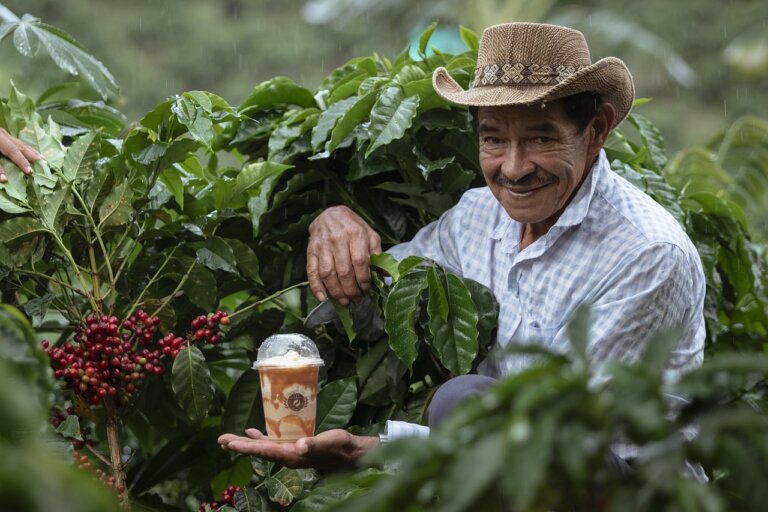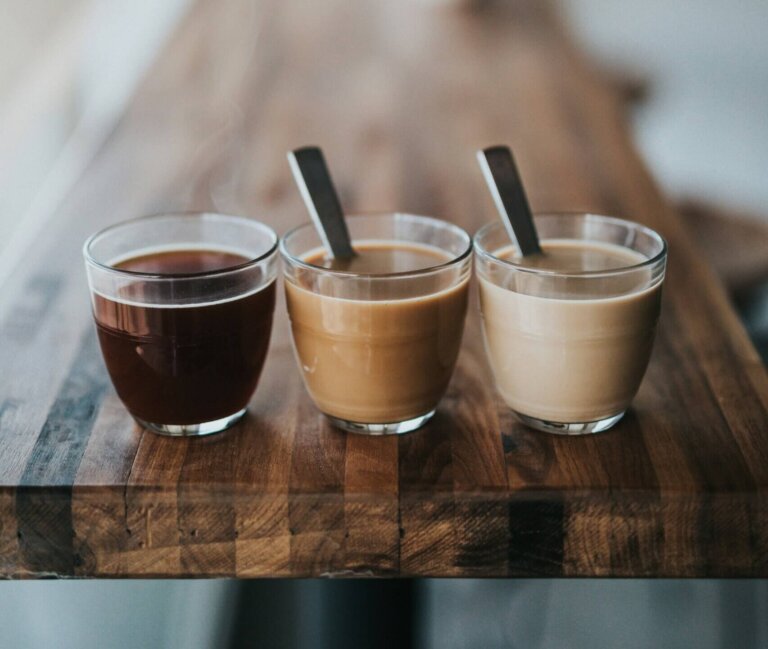An espresso is a concentrated form of coffee that is brewed by forcing hot water through finely-ground coffee beans. This brewing method produces a rich robust flavor and a velvety crema which is the frothy layer that forms on top of the espresso.

It is mostly served in small portions. Espresso is the foundation for many popular coffee drinks like lattes, cappuccinos, and macchiatos. About 3 in 4 Americans drink coffee every day. Its intense flavor and quick preparation make it a favorite among people.
Origin of Espresso
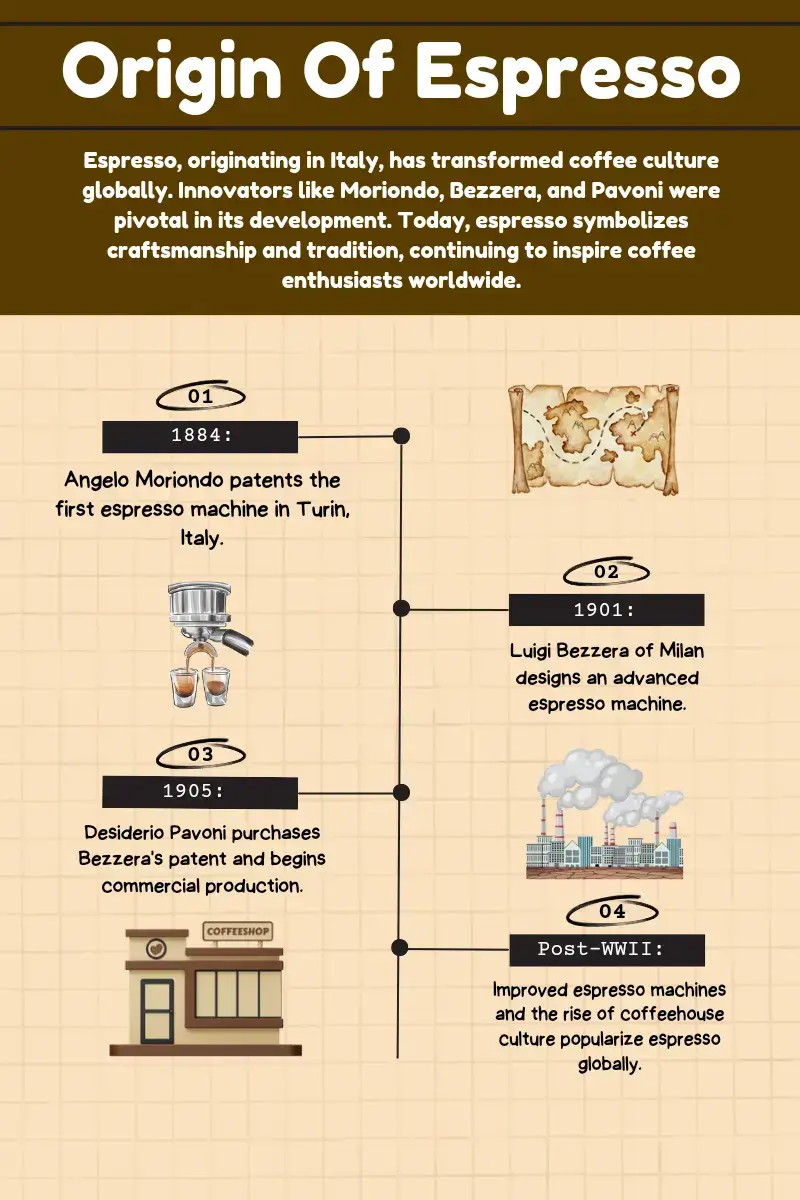
The origin of espresso was in Italy in the early 20th century. The term “espresso” itself means “pressed out” in Italian reflecting the method of preparation where hot water is rapidly forced through finely ground coffee that is why it is named “Espresso”.
The development of the espresso machine is credited to Angelo Moriondo of Turin who patented an early version of it in 1884. But in 1901, it was Luigi Bezzera of Milan who created a more advanced design that closely resembles modern espresso machines.
In 1905 Desiderio Pavoni purchased Bezzera’s patent and started producing the machines commercially, further popularizing espresso in Italy. Over time espresso became an integral part of Italian culture and began spreading internationally.
It gained popularity after World War II with the advent of improved espresso machines and the global rise of coffeehouse culture which gave espresso a high status as a beloved coffee preparation method worldwide.
How To Make An Espresso
While making an espresso you will need the following types of ingredients and equipment.
Ingredients
Here are the ingredients you need to make an espresso.
Coffee Beans or Coffee Ground: Use 8-10 grams of coffee beans for a single shot and 18-20 grams for a double shot. You can also use 1-2 tablespoons of ground coffee.
Hot Water (200°F or 93°C): Use 30-40 ml hot water for a single shot and 60-80 ml for a double shot.
Equipment
- Espresso machine
- Coffee grinder
- Tamper
- Portafilter
- Espresso cup
Step-by-Step Process to Make an Espresso
Here is the step-by-step guide on how to make an espresso.
Step 01. Grind the Coffee Beans
Use a high-quality burr grinder to grind your coffee beans to a fine consistency until it looks like refined salt. This is very important for the extraction process.
Step 02. Preheat the Espresso Machine
Turn on your espresso machine and let it warm up for at least 15-30 minutes and make sure the portafilter is attached to the group head to heat it as well.
Step 03. Measure and Dose the Coffee
Measure out 18-20 grams of ground coffee for a double shot (about 9-10 grams for a single shot). Place the coffee grounds into the portafilter basket.
Step 04. Tamp the Coffee Grounds
Use a tamper to press down the coffee grounds evenly and firmly. Apply around 30 pounds of pressure to ensure a compact puck which will allow an even extraction.
Step 05. Attach the Portafilter
Insert the portafilter into the group head of the espresso machine and lock it in place properly.
Step 06. Start the Extraction
Place your pre-warmed espresso cup under the portafilter spouts. Start the extraction process by activating the machine’s pump.
Step 07. Extract the Espresso
Allow the espresso to extract for about 25-30 seconds. The best volume for a double shot is approximately 2 ounces (60 milliliters). The espresso should have a rich, dark color with a layer of crema on top.
Step 08. Serve and Enjoy
Serve the espresso immediately in a warm cup. Enjoy it on its own or use it as a base for other espresso-based drinks like cappuccinos or lattes.
Difference Between an Espresso and Regular Coffee
Here is the difference in preparation method, grind size, flavor, strength, and caffeine content between an espresso and regular coffee.

Preparation Method
Espresso: Made by forcing hot water through the finely ground coffee at high pressure (typically around 9 bars). This process takes about 25-30 seconds and produces a small, concentrated shot of coffee
Regular Coffee: Usually brewed by methods such as drip, pour-over, or French press, where hot water is allowed to steep through coarse coffee grounds. This process takes several minutes and produces a larger, less concentrated beverage.
Grind Size
Espresso: Espresso uses a very fine grind so it can allow quick extraction under high pressure.
Regular Coffee: Regular coffee uses a coarser grind which is suitable for slower brewing methods.
Flavor and Strength
Espresso: Espresso’s usually has a strong, rich, and concentrated flavor with a thick body and a distinct layer of crema.
Regular Coffee: Regular coffee tends to have a milder and more diluted flavor due to the lower coffee-to-water ratio and longer brewing time.
Serving Size
Espresso: It is mostly served in small 1-ounce (30 ml) shots often in demitasse cups.
Regular Coffee: It is served in larger quantities which range from 8 to 12 ounces (240 to 360 ml) or more in standard coffee mugs.
Caffeine Content
The caffeine content in an espresso shot compared to a regular cup of coffee differentiates due to differences in serving size and concentration.
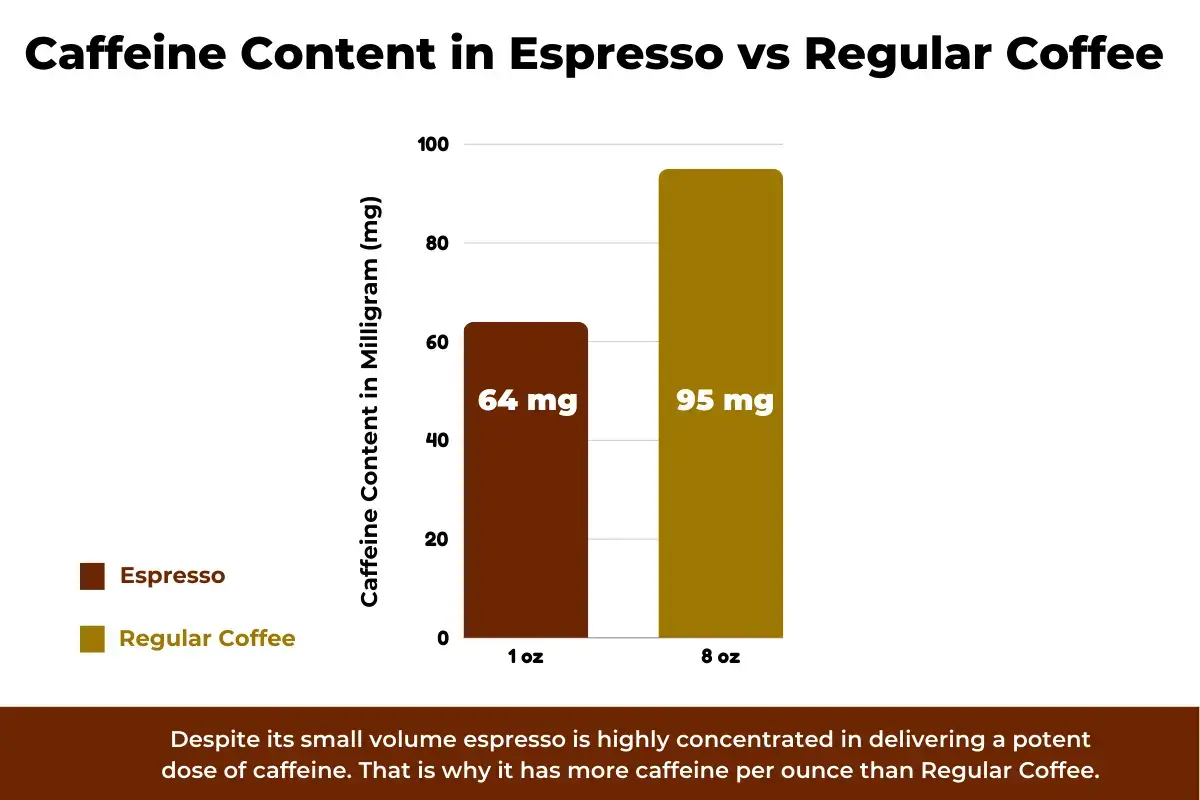
Espresso Shot
A standard 1-ounce (30 ml) shot of espresso mostly contains about 64 milligrams of caffeine. Despite its small volume espresso is highly concentrated in delivering a potent dose of caffeine.
Regular Cup of Coffee
A standard 8-ounce cup of regular coffee generally contains about 95 milligrams of caffeine although this can range from 70 to 140 milligrams depending on the type of coffee bean, brewing method, and serving size.
Comparison
Espresso has more caffeine per ounce (64 mg/1 oz) compared to regular coffee (approximately 12 mg/1 oz).
A regular cup of coffee mostly contains more total caffeine (95 mg in 8 oz) than a single shot of espresso (64 mg in 1 oz).
Types of Espresso Drinks
Here are some of the most common types of espresso and espresso-based beverages.
Single Espresso (Solo)
A single shot of espresso, typically 1 ounce (30 ml) in volume. It’s a concentrated coffee with a strong flavor.
Double Espresso (Doppio)
Two shots of espresso, about 2 ounces (60 ml) total. This is stronger and more intense than a single espresso.
Ristretto
A “short” shot of espresso using the same amount of coffee but less water, resulting in about 0.75 ounces (22 ml) of highly concentrated coffee. It’s sweeter and more intense than a regular espresso.
Lungo
A “long” shot of espresso made with more water, producing about 1.5 ounces (45 ml). It has a milder flavor and a larger volume than a standard espresso.
Americano
Espresso is diluted with hot water, creating a coffee similar to drip coffee but with the espresso’s distinct flavor. The ratio is usually 1 part espresso to 2 parts hot water.
Long Black
Long black is the reverse of Americano. The difference between them is in the preparation. In Americano, espresso is added first, and then hot water is poured over it. In Long Black, Hot water is added first, and then espresso is poured over hot water.
Macchiato
A shot of espresso “marked” with a small amount of steamed milk or milk foam. It’s bolder than a cappuccino or latte due to the higher ratio of coffee to milk.
Cappuccino
Equal parts espresso, steamed milk, and milk foam, typically served in a 6-ounce (180 ml) cup. It has a creamy texture with a strong coffee flavor.
Latte
One shot of espresso with a larger amount of steamed milk and a thin layer of milk foam usually served in an 8-ounce (240 ml) or larger cup. It’s creamier and milder than a cappuccino.
Flat White
Similar to a latte but with less foam and a higher ratio of coffee to milk, resulting in a stronger coffee flavor. It’s typically served in a smaller cup (6-8 ounces or 180-240 ml).
Mocha
A latte with the addition of chocolate syrup or cocoa powder, topped with whipped cream. It’s a sweeter coffee drink with a chocolatey flavor.
Affogato
A shot of espresso poured over a scoop of vanilla ice cream or gelato, creating a dessert-like coffee treat.
Cortado
Equal parts espresso and steamed milk served in a small glass. It balances the intensity of espresso with the creaminess of milk.
How to Drink an Espresso
Drinking an espresso can be quite challenging when you are not used to it. Here are the six steps to drink an espresso.
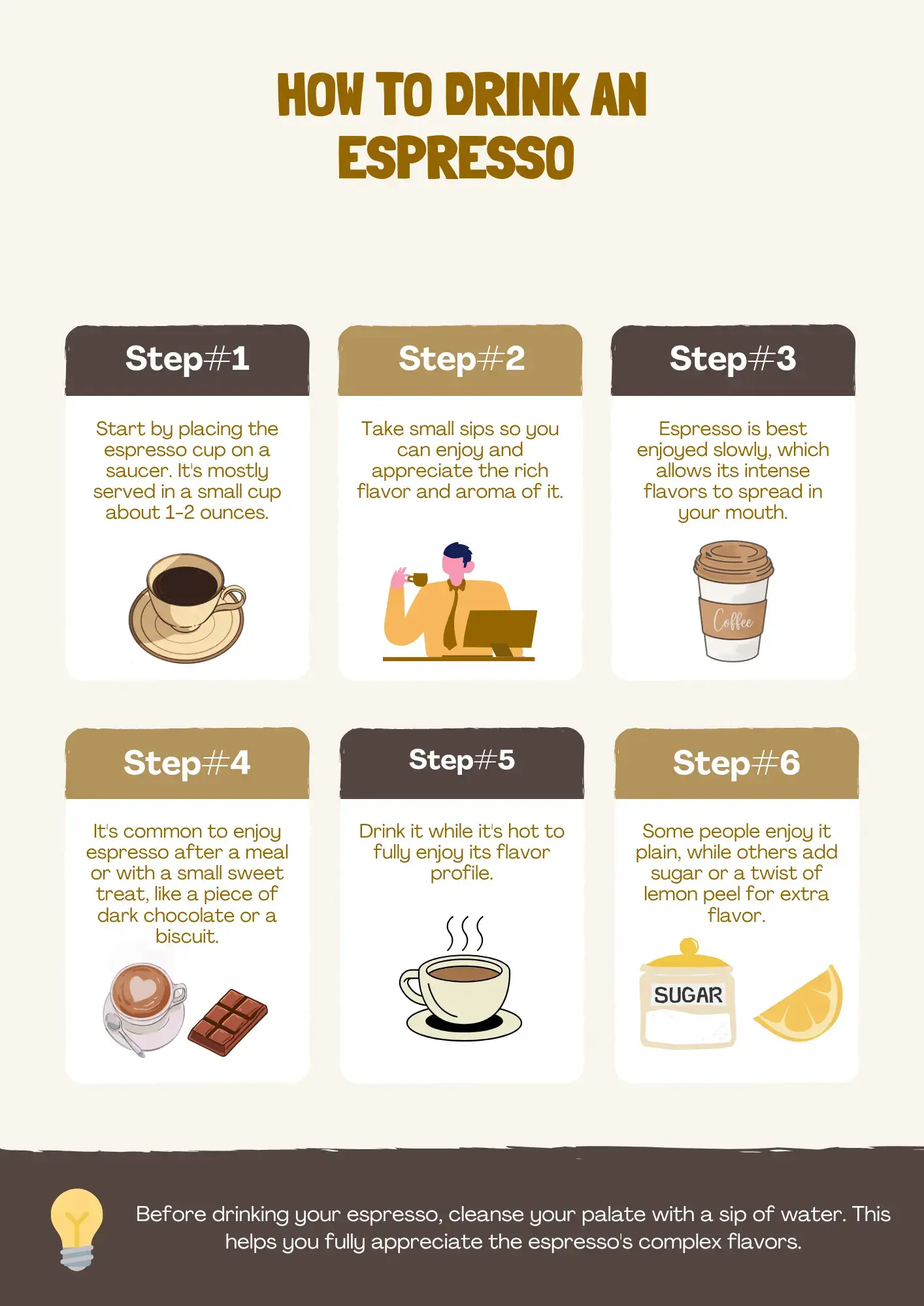
Step 01
Start by placing the espresso cup on a saucer It’s mostly served in a small cup of about 1-2 ounces.
Step 02
Take small sips so you can enjoy and appreciate the rich flavor and aroma of it.
Step 03
Espresso is best enjoyed slowly which allows its intense flavors to spread in your mouth.
Step 04
It’s common to enjoy espresso after a meal or with a small sweet treat, it can be anything like a piece of dark chocolate or a biscuit.
Step 05
Drink it while it’s hot to fully enjoy its flavor profile.
Step 06
Some people enjoy it plain while others add sugar or a twist of lemon peel for extra flavor.
The Impact of Espresso on the Coffee Industry
Innovation in Coffee Preparation
The invention of the espresso machine changed how coffee was brewed which allows faster preparation and a more consistent product. This innovation led to the development of many espresso-based beverages which expanded the variety and creativity within the coffee industry.
Growth of Coffee Shops
Espresso’s quick preparation and strong flavor profile make it the best and easiest for cafes and coffee shops. The espresso machine became a staple in these establishments contributing to the rise of coffee shop culture particularly in urban areas. This trend led to the global rise of coffee chains like Starbucks which are popular espresso drinks worldwide.
Diverse Menu Offerings
Many espresso allowed cafes to offer a wide range of beverages beyond traditional coffee. Drinks like lattes, cappuccinos, macchiatos, and mochas attracted a broader customer base of food service to many tastes and preferences. This diversification helped coffee shops to differentiate between themselves and attract the same customers again and again
Specialty Coffee Movement
Espresso’s focus on quality and precision in brewing contributed to the growth of the specialty coffee movement. This movement focuses on sourcing high-quality beans, refining brewing techniques, and educating consumers about coffee origins and flavors. Espresso bars and specialty cafes have become destinations for coffee lovers who are seeking premium experiences.
Can You Make Espresso Without an Espresso Machine?
Yes, espresso can be made without an espresso machine using these methods:
- AeroPress
- Moka Pot
- Handheld Espresso Maker
These methods don’t don’t have the perfect true taste of espresso but produce similar and strong coffee.
What is the Best Type of Bean to Use for Brewing Espresso?
The best type of bean for brewing espresso is typically a blend of Arabica and Robusta beans though 100% Arabica beans are also popular.
Arabica Beans
Arabica is smooth, sweet, complex in flavors and has notes of fruit and sugar and has a high acidity level, and is more aromatic
Robusta Beans
Robust beans are stronger, harsher, more bitter, and earthy in flavor and have a very high caffeine content and a better crema.
Blend
Blends often use the combination of Arabica for flavor and Robusta for crema and strength and are roasted in medium to dark and these are preferred for their balanced bold flavors.
Conclusion
Espresso is more than just a strong coffee; it’s more like a cornerstone of the coffee world which is liked for its rich flavor, intense aroma, and velvety texture. This concentrated drink was invented in Italy and has transcended its origins to become a global icon integral to various coffee drinks and a staple for coffee lovers.


